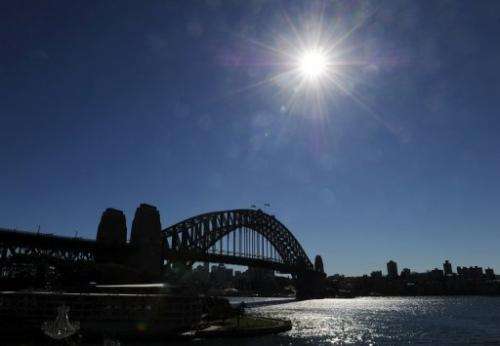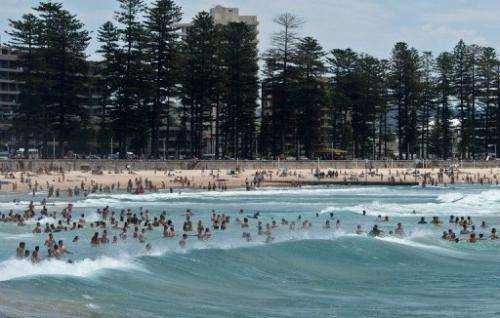This file photo shows cloudless blue skies above the Sydney Harbour Bridge, pictured on May 22, 2012. Temperatures in Sydney on Friday hit their highest levels since records began 150 years ago, after an Australian government agency warned of more frequent and intense heatwaves in the future.
Temperatures in Sydney on Friday hit their highest levels since records began 150 years ago, after an Australian government agency warned of more frequent and intense heatwaves in the future.
While a vicious cold snap has recently hit Russia and eastern Europe and the Middle East has suffered its worst winter storm in a decade, Australian firefighters were battling scores of wildfires in stifling summer heat.
In Sydney, Australia's biggest city, the temperature smashed the previous hottest recorded temperature peaking at 45.8 degrees Celsius (114.4 Fahrenheit). The old record, of 45.3 C, was set in January 1939.
"It's a historic day for Sydney," Weather Channel meteorologist Dick Whitaker said.
"We haven't seen a day like this in Sydney's recorded history."
It is the latest record to fall as Australia swelters under a heatwave that has affected 70 percent of the vast country and created what experts have called a "dome of heat" over the nation's outback centre.
The Bureau of Meteorology said the heatwave had been affecting large parts of Australia since late 2012, and the Sydney record set at Observatory Hill—where the temperature has been measured since 1859—was just the latest.
"The record setting temperatures were not limited to Sydney, with records being set along the coast," the bureau said.
"The highest temperature recorded in the Greater Sydney Area was 46.5 C at Penrith."
Sydneysiders and tourists cool off in the sea at Manly beach in Sydney, on January 8, 2013. Temperatures in Sydney hit their highest level on record on Friday, with the mercury in Australia's biggest city reaching 45.8 degrees Celsius in the mid-afternoon.
The scorching heat follows an extended period of exceptionally widespread hot weather for Australia in which the nation experienced its hottest day on record on January 7 with the average maximum temperature hitting 40.33 degrees.
The extreme weather, which has exacerbated bushfires, last week also saw the government's weather bureau upgrade its temperature scale by introducing new colours to cover projected forecast highs.
At one point last week, central Australia was shown with a purple area on the bureau's forecast map, a new colour code suggesting temperatures were set to soar above 50 degrees (122 Fahrenheit).
Australia's all-time record temperature is 50.7 degrees, set in January 1960 at Oodnadatta in South Australia state.
The record weather comes as police said one man died Friday in a bushfire in Victoria, with his body found in a burnt-out car in the Seaton area in the state's southeast.
Firefighters are battling blazes in New South Wales and Victoria, almost two weeks after a dangerous fire in the southern island state of Tasmania razed more than 100 homes.
The unprecedented heatwave prompted the government's Climate Commission to issue a new report on the weather event last weekend.
It said climate change had contributed to making the extreme heat conditions and bushfires even worse.
"The length, extent and severity of the current heatwave are unprecedented in the measurement record," the report "Off the Charts: Extreme Australian summer heat" noted.
"Although Australia has always had heatwaves, hot days and bushfires, climate change is increasing the risk of more frequent and longer heatwaves and more extreme hot days, as well as exacerbating bushfire conditions."
(c) 2013 AFP

























